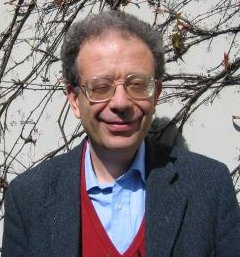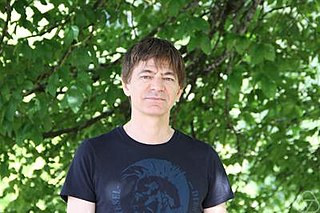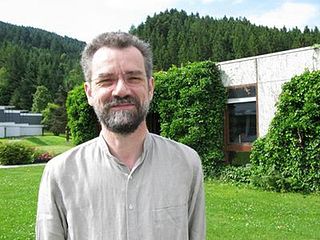Related Research Articles

Sir Andrew John Wiles is an English mathematician and a Royal Society Research Professor at the University of Oxford, specializing in number theory. He is best known for proving Fermat's Last Theorem, for which he was awarded the 2016 Abel Prize and the 2017 Copley Medal by the Royal Society. He was appointed Knight Commander of the Order of the British Empire in 2000, and in 2018 was appointed as the first Regius Professor of Mathematics at Oxford. Wiles is also a 1997 MacArthur Fellow.
The modularity theorem states that elliptic curves over the field of rational numbers are related to modular forms. Andrew Wiles proved the modularity theorem for semistable elliptic curves, which was enough to imply Fermat's Last Theorem. Later, a series of papers by Wiles's former students Brian Conrad, Fred Diamond and Richard Taylor, culminating in a joint paper with Christophe Breuil, extended Wiles's techniques to prove the full modularity theorem in 2001.

John Henry Coates, FRS is a mathematician who was the Sadleirian Professor of Pure Mathematics at the University of Cambridge in the United Kingdom from 1986 to 2012.

John Torrence Tate Jr. was an American mathematician, distinguished for many fundamental contributions in algebraic number theory, arithmetic geometry and related areas in algebraic geometry. He was awarded the Abel Prize in 2010.
In number theory, Iwasawa theory is the study of objects of arithmetic interest over infinite towers of number fields. It began as a Galois module theory of ideal class groups, initiated by Kenkichi Iwasawa (1959), as part of the theory of cyclotomic fields. In the early 1970s, Barry Mazur considered generalizations of Iwasawa theory to abelian varieties. More recently, Ralph Greenberg has proposed an Iwasawa theory for motives.
In mathematics, the Birch and Swinnerton-Dyer conjecture describes the set of rational solutions to equations defining an elliptic curve. It is an open problem in the field of number theory and is widely recognized as one of the most challenging mathematical problems. It is named after mathematicians Bryan John Birch and Peter Swinnerton-Dyer, who developed the conjecture during the first half of the 1960s with the help of machine computation. As of 2021, only special cases of the conjecture have been proven.
In mathematics, an Euler system is a collection of compatible elements of Galois cohomology groups indexed by fields. They were introduced by Kolyvagin (1990) in his work on Heegner points on modular elliptic curves, which was motivated by his earlier paper Kolyvagin (1988) and the work of Thaine (1988). Euler systems are named after Leonhard Euler because the factors relating different elements of an Euler system resemble the Euler factors of an Euler product.

Don Bernard Zagier is an American-German mathematician whose main area of work is number theory. He is currently one of the directors of the Max Planck Institute for Mathematics in Bonn, Germany. He was a professor at the Collège de France in Paris, France from 2006 to 2014. Since October 2014, he is also a Distinguished Staff Associate at ICTP.

In mathematics, arithmetic geometry is roughly the application of techniques from algebraic geometry to problems in number theory. Arithmetic geometry is centered around Diophantine geometry, the study of rational points of algebraic varieties.

Jean-Michel Bismut is a French mathematician who has been a Professor at the Université Paris-Sud since 1981. His mathematical career covers two apparently different branches of mathematics: probability theory and differential geometry. Ideas from probability play an important role in his works on geometry.

Wiles's proof of Fermat's Last Theorem is a proof by British mathematician Andrew Wiles of a special case of the modularity theorem for elliptic curves. Together with Ribet's theorem, it provides a proof for Fermat's Last Theorem. Both Fermat's Last Theorem and the modularity theorem were almost universally considered inaccessible to proof by contemporaneous mathematicians, meaning that they were believed to be impossible to prove using current knowledge.
In mathematics, the main conjecture of Iwasawa theory is a deep relationship between p-adic L-functions and ideal class groups of cyclotomic fields, proved by Kenkichi Iwasawa for primes satisfying the Kummer–Vandiver conjecture and proved for all primes by Mazur and Wiles (1984). The Herbrand–Ribet theorem and the Gras conjecture are both easy consequences of the main conjecture. There are several generalizations of the main conjecture, to totally real fields, CM fields, elliptic curves, and so on.

Pierre Colmez is a French mathematician, notable for his work on p-adic analysis.

Kai Behrend is a German mathematician. He is a professor at the University of British Columbia in Vancouver, British Columbia, Canada.
Lawrence Clinton Washington is an American mathematician at the University of Maryland, who specializes in number theory.
Haruzo Hida is a Japanese mathematician, known for his research in number theory, algebraic geometry, and modular forms.
William Drexel Duke is an American mathematician specializing in number theory.
Christopher McLean Skinner is an American mathematician working in number theory and arithmetic aspects of the Langlands program. He specialises in algebraic number theory.

Eric Jean-Paul Urban is a professor of mathematics at Columbia University working in number theory and automorphic forms, particularly Iwasawa theory.

Peter Bernd Schneider is a German mathematician, specializing in the p-adic aspects of algebraic number theory, arithmetic algebraic geometry, and representation theory.
References
- 1 2 3 4 5 "2007 Coxeter–James Prize" (PDF). Canadian Mathematical Society . 2007.
- ↑ "Vinayak Vatsal – The Mathematics Genealogy Project". www.genealogy.math.ndsu.nodak.edu. Retrieved 2019-03-07.